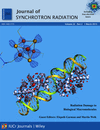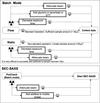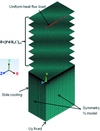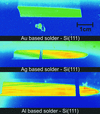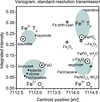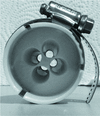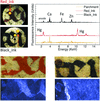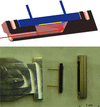issue contents
March 2015 issue
Includes papers presented at the 8th International Workshop on X-ray Radiation Damage to Biological Crystalline Samples
Hamburg, Germany, 10-12 April 2014

Cover illustration: Specific radiation damage to an iron-sulfur cluster in ferredoxin caused by ultra-short and intense X-FEL pulses (upper panel; see Nass et al., pages 225-238) and specific radiation damage to the protein moiety of a protein-DNA complex cased by synchrotron radiation (lower panel; see Bury et al., pages 213-224).
facility information
radiation damage
Free 

Radiation damage during X-ray data collection remains a challenge in structural biology. Eight papers in the Special Issue are placed in the context of recent research in this area.
Open  access
access
 access
accessA metric indicating the relative level of specific radiation damage for individual atoms, that can be calculated from refined and deposited protein structure models, is presented.
Open  access
access
 access
accessQuantitative X-ray induced radiation damage studies employing a model protein–DNA complex revealed a striking partition of damage sites. The DNA component was observed to be far more resistant to specific damage compared with the protein.
High-dose serial femtosecond crystallography experiments were performed on microcrystals of the metalloprotein ferredoxin. Indications of radiation damage to the two [4Fe–4S] clusters are observed.
Open  access
access
 access
accessBragg spots recorded from a still crystal necessarily give partial measurements of the structure factor intensity. Correction to the full-spot equivalent, relying on both a physical model for crystal disorder and postrefinement of the crystal orientation, improves the electron density map in serial crystallography.
Experimental phasing remains an important technical goal in free-electron laser (FEL) serial femtosecond crystallography (SFX) experiments. Here, it is shown that simulated native SFX cathepsin B data can be phased by rapid changes to atomic scattering factors induced by FEL pulses.
Simulations show that temporal pulse profile is a factor to consider when performing nanocrystallography at free-electron lasers.
Results of a scanning X-ray diffraction experiment performed on a biological sample prepared with a focused ion beam of gallium atoms are reported for the first time.
Simple and effective strategies to curb the effects of radiation damage for solution-based biological SAXS investigations have been implemented for user operations at the EMBL P12 beamline.
lead articles
Free 

Newly developed methods for time-resolved photocrystallographic studies using the polychromatic pink-Laue technique, suitable for medium- and small-size unit cells typical in chemical crystallography, are summarized.
Free 

A rigorous theory of the brightness from synchrotron radiation sources based on Wigner distributions is discussed. Results for bending magnets and undulators are compared with those in the literature, highlighting similarities and differences.
research papers
The thermal stresses of multilayer optics under the exposure of synchrotron radiation X-ray white beam are simulated by finite-element analysis.
A new monochromator called an extra-focus constant-included-angle varied-line-spacing cylindrical-grating monochromator (extra-focus CIA-VCGM) is described. It is based on the Hettrick–Underwood scheme where the plane varied-line-spacing grating is replaced by a cylindrical one in order to zero the defocus at three reference photon energies in the VUV range.
A microscopy system designed and constructed to accommodate multilayer Laue lenses as nanofocusing optics is presented.
A study of metallic brazing material for internally cooled optics is presented, showing the influence of the different material properties on the final quality of the bond in terms of diffracted wavefront distortion, i.e. enlargement of the rocking curve.
Reflectivity versus soft X-ray energy and in-depth profiles of chemical elements of a-C-, B4C- and Ni-coated grazing-incidence mirrors are studied experimentally. The possibility to use B4C- and Ni-coated mirrors near the carbon K-edge of absorption is demonstrated.
The validation of a Geant4 model of the X-ray Fluorescence Microprobe end-station at the Australian Synchrotron is presented.
The evolution of the PbO2 and PbSO4 surface layers formed on a pure lead anode during electrochemical cycling relevant to electrowinning operations is characterized by in situ synchrotron X-ray diffraction and subsequent Rietveld-based quantitative phase analysis and thickness calculations. The design of a novel reflection geometry electrochemical flow cell is also described.
Noncrystalline nickel phosphide nanoparticles have been synthesized, and their morphology, particle size, element contents, local atomic structures, as well as the catalysis in the thermal decomposition of ammonium perchlorate were studied.
The theory of heterodyne/stroboscopic detection of nuclear resonance scattering is developed for various dynamical scattering channels. The grazing-incidence case is discussed in detail and is experimentally demonstrated on isotope periodic and magnetic multilayers.
Open  access
access
 access
accessA method to evaluate chemical element concentrations in samples by generating an effective polychromatic beam using as initial input real monochromatic beam data is presented.
Open  access
access
 access
accessA summarising review of data treatment for non-resonant inelastic X-ray scattering data from modern synchrotron-based multi-analyzer spectrometers.
The extension of pre-edge peak analysis at the Fe K-edge to catalysis research and operando spectroscopic applications by comparison of high-resolution and conventional X-ray absorption spectra is presented.
Experimental studies of 57Fe polarization-dependent synchrotron radiation Mössbauer spectroscopy using a diamond X-ray phase plate and an iron borate nuclear Bragg monochromator are introduced.
NEUTRON | SYNCHROTRON
Open  access
access
 access
accessFluorescence detector strategies are compared for dilute XAFS samples on high flux beamlines.
Open  access
access
 access
accessThe heavy-element content of ink in ancient administrative documents makes it possible to detect the characters with different synchrotron imaging techniques, based on attenuation or refraction. This is the first step in the direction of non-interactive virtual X-ray reading.
An improved method for registration of the rotation axis in X-ray tomographic data that takes both tilting and translation errors into consideration is presented.
short communications
A method to pre-shape mirror substrates using a commercial broad-beam ion source and a contoured mask is presented.
Open  access
access
 access
accessA small and robust active beamstop for scattering experiments on high-brilliance undulator beamlines
Using an indirect detection scheme, a small-size beamstop was developed to accurately measure X-ray beam flux in a wide energy range with reduced radiation level on the electronics and significantly increased in-beam lifetime.
beamlines
Open  access
access
 access
accessCDApps software at Diamond B23 SRCD beamline is presented.
addenda and errata
Open  access
access
 access
accessA correction to the article by Thibault et al. [J. Synchrotron Rad. (2014), 21, 1011–1018] is given.
current events
Free 



 journal menu
journal menu

















